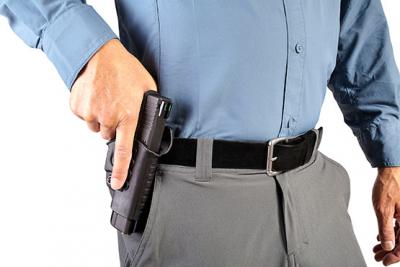Retired Officers Annual Qualification
HR 218
The Coos County Sheriff's Office hosts annual firearms qualifications which meet the requirements of H.R. 218, as set forth by Department of Public Safety Standards and Training.
In accordance with 18 USC 926C,[5] a "qualified retired law enforcement officer" is an individual who:
- Separated from service in good standing from service with a public agency as a law enforcement officer;
- Before such separation, was authorized by law to engage in or supervise the prevention, detection, investigation, or prosecution of, or the incarceration of any person for, any violation of law, and had statutory powers of arrest or apprehension under section 807(b) of title 10, United States Code (article 7(b) of the Uniform Code of Military Justice);
- Before such separation, served as a law enforcement officer for an aggregate of 10 years or more; or separated from service with such agency, after completing any applicable probationary period of such service, due to a service-connected disability, as determined by such agency;
- During the most recent 12-month period, has met, at the expense of the individual, the standards for qualification in firearms training for active law enforcement officers, as determined by the former agency of the individual, the State in which the individual resides or, if the State has not established such standards, either a law enforcement agency within the State in which the individual resides or the standards used by a certified firearms instructor that is qualified to conduct a firearms qualification test for active duty officers within that State;
- Has not been officially found by a qualified medical professional employed by the agency to be unqualified for reasons relating to mental health and as a result of this finding will not be issued photographic identification; or has not entered into an agreement with the agency from which the individual is separating from service in which that individual acknowledges he or she is not qualified under this section for reasons relating to mental health and for those reasons will not receive or accept photographic identification;
- Is not under the influence of alcohol or another intoxicating or hallucinatory drug or substance; and
- Is not prohibited by Federal law from receiving a firearm.
- Additionally, the individual must carry either:
- photographic identification issued by the agency from which the individual separated from service as a law enforcement officer that identifies the person as having been employed as a police officer or law enforcement officer and indicates that the individual has, not less recently than one year before the date the individual is carrying the concealed firearm, been tested or otherwise found by the agency to meet the active duty standards for qualification in firearms training as established by the agency to carry a firearm of the same type as the concealed firearm; or
- photographic identification issued by the agency from which the individual separated from service as a law enforcement officer that identifies the person as having been employed as a police officer or law enforcement officer; and a certification issued by the State in which the individual resides or by a certified firearms instructor that is qualified to conduct a firearms qualification test for active duty officers within that State that indicates that the individual has, not less than one year before the date the individual is carrying the concealed firearm, been tested or otherwise found by the State or a certified firearms instructor that is qualified to conduct a firearms qualification test for active duty officers within that State to have met the active duty standards for qualification in firearms training, as established by the State, to carry a firearm of the same type as the concealed firearm; or if the State has not established such standards, standards set by any law enforcement agency within that State to carry a firearm of the same type as the concealed firearm.
Law Enforcement Officers Safety Act of 2004 (HR 218)
On July 22, 2004, President George W. Bush signed into legislation a new federal law, which exempts law enforcement officers from state law prohibiting carrying concealed firearms. The law allows "qualified" law enforcement officers, current or retired, to carry a concealed firearm in any state without a concealed handgun permit. On October 12, 2010, President Barack Obama signed the Law Enforcement Safety Improvement Act improving the ability of retired officers to comply with the documents required when carrying a firearm under this law and making other modifications to existing law.
HR 218 DOES NOT specifically supersede state law regulating possession of firearms in public buildings such as courthouses and schools; the only application is to carrying concealed handguns. Therefore, a retired officer MAY NOT carry a concealed handgun in a public building, as prohibited in ORS 166.370 - the new law does not change this.
For more information on range dates contact: Dede Clements CCSORecords@co.coos.or.us

